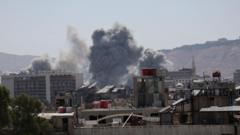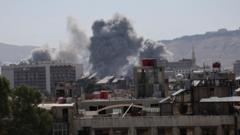Amid the aftermath of Syria's civil war, citizens are actively engaged in rescuing and commemorating the remnants of their battle against oppressive governance. This effort aims to serve as both a historical record and a cautionary reminder to prevent future atrocities.
The Urgent Quest to Document Syria's Revolutionary Past

The Urgent Quest to Document Syria's Revolutionary Past
As Syria mourns its tumultuous history, many citizens endeavor to preserve artifacts of their civil struggle for future generations.
In the wake of Syria’s civil conflict, which spanned nearly 14 years, the citizens are rallying to safeguard the remnants of a revolution that sought to dismantle the regime of Bashar al-Assad. Throughout the country, particularly in places like Kafranbel and Sednaya, there is an urgent push to capture the physical manifestations of their struggle—banners, graffiti, sculptures formed from spent artillery shells, and harrowing artifacts from torture practices. This effort is driven by a deep-seated desire to keep their painful history alive and to ensure that such experiences are documented for future generations.
Mutassim Abdulsatir, a former inmate of the infamous Sednaya prison, articulates the sentiment shared by many: “These must become a remembrance for days to come so they are not repeated, not in Syria, and not in any country in the world.” His determination is evident as he meticulously collects nooses and other symbols of suffering from the prison grounds, envisioning them preserved for educational purposes in the future.
Others, too, are undertaking significant efforts to salvage crucial documentation and evidence from the ousted regime, with hopes that these materials will contribute to justice and accountability in the future. The movement reflects a collective ambition not only to memorialize the resistance against tyranny but also to serve as a sober warning against the recurrence of such injustices in Syria and beyond.
As the nation grapples with the scars left by the civil war, this initiative to archive the memories serves not only as a means of remembrance but also as an essential step in the quest for healing amidst a legacy of pain.
Mutassim Abdulsatir, a former inmate of the infamous Sednaya prison, articulates the sentiment shared by many: “These must become a remembrance for days to come so they are not repeated, not in Syria, and not in any country in the world.” His determination is evident as he meticulously collects nooses and other symbols of suffering from the prison grounds, envisioning them preserved for educational purposes in the future.
Others, too, are undertaking significant efforts to salvage crucial documentation and evidence from the ousted regime, with hopes that these materials will contribute to justice and accountability in the future. The movement reflects a collective ambition not only to memorialize the resistance against tyranny but also to serve as a sober warning against the recurrence of such injustices in Syria and beyond.
As the nation grapples with the scars left by the civil war, this initiative to archive the memories serves not only as a means of remembrance but also as an essential step in the quest for healing amidst a legacy of pain.




















